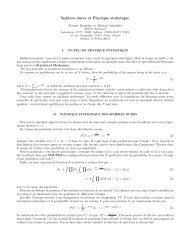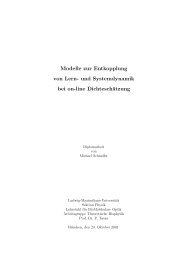Thesis (pdf) - Espci
Thesis (pdf) - Espci
Thesis (pdf) - Espci
Create successful ePaper yourself
Turn your PDF publications into a flip-book with our unique Google optimized e-Paper software.
1 General introduction 3<br />
led me, irremediably, to devote this thesis and my future research to biophysics.<br />
This thesis do not respond to a pre-established scheme, although there is a<br />
logic underlying the pattern followed, which starts from a string theory PhD<br />
student during the first two years of my doctorate, and ends as a biophysicist.<br />
The transition between such a perpendicular fields has resulted in the following<br />
thesis, where aspects of purely soft matter concerning topological defects<br />
appear first, followed by a study of some cooperativity of molecular motors,<br />
and ends with a purely biophysical approach of membrane-cytoskeleton interactions<br />
which explicitly connects with biological experiments. Yet from<br />
the beginning I tried to work on problems that allowed me to interact with<br />
experiments and researchers from other fields.<br />
This thesis is composed of three chapters which are devoted to soft-matter<br />
and physical biology. The first chapter belongs to the field of topological defects.<br />
The study of topological defects is of general relevance in many areas of<br />
physics and biology, because their main universal properties can help understand<br />
systems that presumably exhibit topological defects, such as the mitotic<br />
spindle during cell division, using simple condensed matter experiments, like<br />
in liquid crystals. We consider the motion of defects and their interaction,<br />
which is not fully understood. In this regard, we study the dynamics of annihilation<br />
of two defects in Langmuir monolayers using a liquid crystal model.<br />
We are able to extract the dependence of the elastic anisotropy of the material<br />
on the surface pressure measuring only the ratio of velocities at which the<br />
defects approach each other.<br />
In the second chapter of the thesis, we consider some aspects of selforganization<br />
and cooperativity of molecular motors. Molecular motors are<br />
proteins that convert chemical energy into mechanical work at a molecular<br />
scale, and are responsible of many biological phenomena, ranging from muscle<br />
contraction to cellular transport and cell motility. Molecular motors usually<br />
cooperate to generate large forces, as in the case of muscle contraction.<br />
Although there are several theoretical works considering the coupling between<br />
molecular motors, there is not yet a full understanding of cooperativity<br />
and force distribution among clusters of molecular motors. We consider several<br />
representative weakly interactions between motors, namely, short range<br />
and long range repulsion, and weak attraction, and we study their collective<br />
behavior, force distribution and efficiency when a force is applied in the foremost<br />
motor. Our approach is mainly based on Langevin simulations using a<br />
two state model for a molecular motor.




